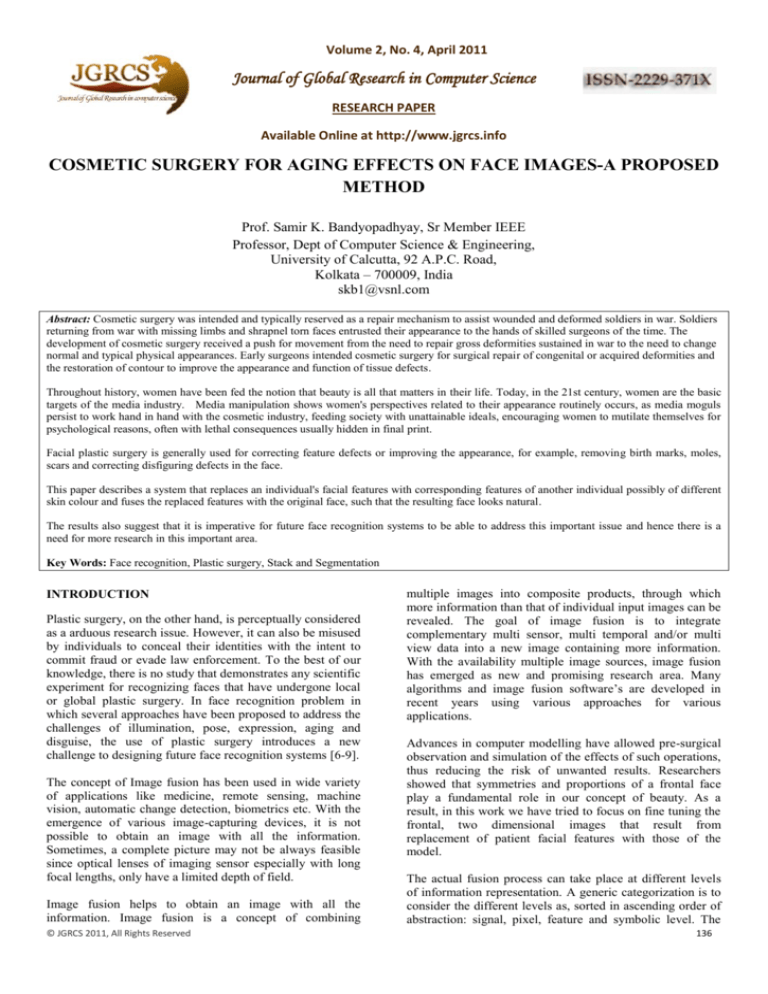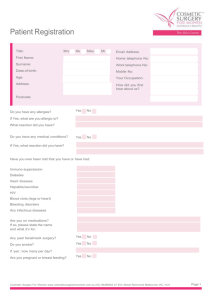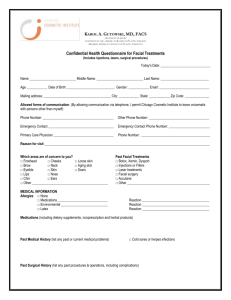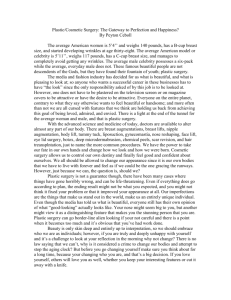
Volume 2, No. 4, April 2011
Journal of Global Research in Computer Science
RESEARCH PAPER
Available Online at http://www.jgrcs.info
COSMETIC SURGERY FOR AGING EFFECTS ON FACE IMAGES-A PROPOSED
METHOD
Prof. Samir K. Bandyopadhyay, Sr Member IEEE
Professor, Dept of Computer Science & Engineering,
University of Calcutta, 92 A.P.C. Road,
Kolkata – 700009, India
skb1@vsnl.com
Abstract: Cosmetic surgery was intended and typically reserved as a repair mechanism to assist wounded and deformed soldiers in war. Soldiers
returning from war with missing limbs and shrapnel torn faces entrusted their appearance to the hands of skilled surgeons of the time. The
development of cosmetic surgery received a push for movement from the need to repair gross deformities sustained in war to the need to change
normal and typical physical appearances. Early surgeons intended cosmetic surgery for surgical repair of congenital or acquired deformities and
the restoration of contour to improve the appearance and function of tissue defects.
Throughout history, women have been fed the notion that beauty is all that matters in their life. Today, in the 21st century, women are the basic
targets of the media industry. Media manipulation shows women's perspectives related to their appearance routinely occurs, as media moguls
persist to work hand in hand with the cosmetic industry, feeding society with unattainable ideals, encouraging women to mutilate themselves for
psychological reasons, often with lethal consequences usually hidden in final print.
Facial plastic surgery is generally used for correcting feature defects or improving the appearance, for example, removing birth marks, moles,
scars and correcting disfiguring defects in the face.
This paper describes a system that replaces an individual's facial features with corresponding features of another individual possibly of different
skin colour and fuses the replaced features with the original face, such that the resulting face looks natural.
The results also suggest that it is imperative for future face recognition systems to be able to address this important issue and hence there is a
need for more research in this important area.
Key Words: Face recognition, Plastic surgery, Stack and Segmentation
INTRODUCTION
Plastic surgery, on the other hand, is perceptually considered
as a arduous research issue. However, it can also be misused
by individuals to conceal their identities with the intent to
commit fraud or evade law enforcement. To the best of our
knowledge, there is no study that demonstrates any scientific
experiment for recognizing faces that have undergone local
or global plastic surgery. In face recognition problem in
which several approaches have been proposed to address the
challenges of illumination, pose, expression, aging and
disguise, the use of plastic surgery introduces a new
challenge to designing future face recognition systems [6-9].
The concept of Image fusion has been used in wide variety
of applications like medicine, remote sensing, machine
vision, automatic change detection, biometrics etc. With the
emergence of various image-capturing devices, it is not
possible to obtain an image with all the information.
Sometimes, a complete picture may not be always feasible
since optical lenses of imaging sensor especially with long
focal lengths, only have a limited depth of field.
Image fusion helps to obtain an image with all the
information. Image fusion is a concept of combining
© JGRCS 2011, All Rights Reserved
multiple images into composite products, through which
more information than that of individual input images can be
revealed. The goal of image fusion is to integrate
complementary multi sensor, multi temporal and/or multi
view data into a new image containing more information.
With the availability multiple image sources, image fusion
has emerged as new and promising research area. Many
algorithms and image fusion software’s are developed in
recent years using various approaches for various
applications.
Advances in computer modelling have allowed pre-surgical
observation and simulation of the effects of such operations,
thus reducing the risk of unwanted results. Researchers
showed that symmetries and proportions of a frontal face
play a fundamental role in our concept of beauty. As a
result, in this work we have tried to focus on fine tuning the
frontal, two dimensional images that result from
replacement of patient facial features with those of the
model.
The actual fusion process can take place at different levels
of information representation. A generic categorization is to
consider the different levels as, sorted in ascending order of
abstraction: signal, pixel, feature and symbolic level. The
136
Prof. Samir K. Bandyopadhyay et al, Journal of Global Research in Computer Science, 2 (4), April 2011
lowest possible technique in image fusion is the pixel level,
is called as nonlinear method, in which the intensity values
of pixels of the source images are used for merging the
images. The next level is the feature level, which operates
on characteristics such as size, shape, edge etc. The next
highest level called decision level fusion deals with
symbolic representations of the images [1].
Currently, most of the image fusion has been performed
using pixel based methods [2-3]. A new multi-focus image
fusion algorithm, which is on the basis of the Ratio of
Blurred and Original Image Intensities, was proposed in [4].
A multi focus image fusion method using spatial frequency
(SF) and morphological operators was proposed in [5].The
advantage of the pixel level image fusion is that images
contain original information. Furthermore it is easy to
implement. Image fusion methods based on wavelet
transform have been widely used in recent years. A simple
image fusion algorithm based on wavelet transform is
proposed in reference [6].
A new multi-focus image fusion scheme based on wavelet
contrast is given in reference [7].A novel multi focus image
fusion algorithm based on contour let transform and region
statistics was proposed in [8]. A simple yet efficient
algorithm for multi focus image fusion, using a multi
resolution signal decomposition scheme was proposed in
[9]. A paper given in reference [10] presents an overview on
image fusion techniques using multi resolution
decompositions. A paper in reference [11] is image fusion
tutorial based on wavelet decomposition, i.e. a multi
resolution image fusion approach. Paper in reference [12]
presents the use of balanced multi wavelets for image
fusion.
A new method is developed to merge two spatially
registered images with different focus based on multiresolution wavelet decomposition and evolutionary strategy
(ES) [13]. A multi focus image fusion algorithm using the
Haar transform is presented in the paper [14]. Paper[15]
proposes a method for multi-focus image fusion using pulse
coupled neural network (PCNN).The application of artificial
neural networks to this pixel level multi focus image fusion
problem based on the use of image blocks is explained in
[16]. A novel adaptive multi-focus image fusion algorithm is
given in this paper, which is based on the improved pulse
coupled neural network(PCNN) model, the fundamental
characteristics of the multi-focus image and the properties of
visual imaging[17].
In addition to the classical problems of face finding and
feature detection, our system addresses and solves the
problem of fusing a face with facial features belonging to
another individual -possible of different colour. This is
required in order to achieve a natural looking result.
REVIEW WORKS
When an individual undergoes plastic surgery, the facial
features are reconstructed either globally or locally. In
general, this process changes the appearance. Until now, no
attempt has been made to study the effect of local and global
© JGRCS 2011, All Rights Reserved
plastic surgery on face recognition. Researchers investigate
different aspects related to plastic surgery and face
recognition.
In general, face recognition algorithms can be classified into
three categories: appearance-based, feature-based, and
texture-based algorithms. Appearance based algorithms such
as Principal Component Analysis (PCA) [10], Independent
Component Analysis (ICA) [11], and Fisher Discriminant
Analysis (FDA) [10] usually rely on the global semblance of
features. Feature-based algorithms [12] generally establish a
relationship among facial features and perform matching.
Texture-based algorithms are on the other hand relying on
the facial texture information to recognize an individual.
Most of the existing face recognition algorithms have
predominantly focused on mitigating the effects of pose,
illumination and expression, while the challenges of face
recognition due to aging and disguise still remains.
As these procedures become more and more prevalent,
future face recognition systems will be challenged to
recognize individuals after plastic surgery has been
performed. The major reasons for the problem not being
studied are:
• Due to the sensitive nature of the process and the privacy
issues involved, it is extremely difficult to prepare a face
database that contains images before and after surgery.
• After surgery, the geometric relationship between the
facial features changes significantly and there is no
technique to detect and measure such type of alterations.
Proposed Method
Blending and replacing facial features needs a two level
processing. On one hand, it is required that the shape of the
original shape be changed to that of the desired face, and on
the other hand it is desired that the colour of the replaced
feature be same as the original feature. The final
requirement is crucial if we are to achieve a seamless
transition from the replaced feature to the underlying face.
In general, plastic surgery can be divided into two distinct
categories.
A. Disease Correcting Local Plastic Surgery (Local
Surgery): This is the kind of surgery in which an individual
undergoes local plastic surgery for correcting defects,
anomalies, or improving skin texture. Example of disease
correcting local plastic surgery would be surgery for
correcting jaw and teeth structure, nose structure, chin,
forehead, and eyelids. Although the global approach may
look similar, this type of surgery usually leads to varying
amount of changes in the geometric distance between facial
features. Such changes may cause errors in automatic face
recognition and degrade the system performance.
B. Plastic Surgery for Reconstructing Complete Facial
Structure (Global Surgery): Apart from local surgery, plastic
surgery can be done to completely change the facial
structure which is known as full face lift. This medical
procedure is recommended for cases such as patients with
fatal burn or trauma. In this type of surgery, the appearance,
137
Prof. Samir K. Bandyopadhyay et al, Journal of Global Research in Computer Science, 2 (4), April 2011
texture and facial features of an individual are reconstructed
and are usually not the same as the original face. The
procedure is very useful for patients, but it can also be
misused by criminals or individuals who want to remain
elusive from law enforcement. Thus using this procedure,
the face recognition system can be easily manipulated and
made ineffective.
Input: Input Facial Image and Model Facial Image
When an individual undergoes plastic surgery, the facial
features are reconstructed either globally or locally. In
general, this process changes the appearance. In this paper,
we performed an experimental study to visualize the effect
of both local and global plastic surgery on face recognition.
We obtained face images before and after plastic surgery
from different plastic surgeons and prepared a plastic
surgery database. This database contains a wide variety of
cases such as Rhinoplasty (nose surgery), Mentoplasty (chin
surgery), Brow lift, Malar augmentation (cheek implant),
Skin peeling, and Rhytidectomy (face lift).
Step 2. Draw a vertical line along this pixel from top to
bottom representing the Left baseline or
boundary.
Step 3. Scan the facial image from the right side of the
image to locate the rightmost pixel of the facial
region.
Step 4. Draw a vertical line along this pixel from top to
bottom.
Step 5. Partition the obtained rectangle horizontally into
segments and start with the first row of the first
segment.
Step 6. Scan the enclosed rectangle from the right side to
left, from the first row of the segment.
Step 7. Obtain a pixel that has similar/near similar pixel
value, traverse the pixel path by considering all
the surrounding pixels in a clockwise mannar and
replace the corrosponding pixels by the pixels of
model face.
Step 8. Stack to be used only if the traversal process
reaches a dead end.
Step 9. If a dead end is reached, pop out from the stack a
lesser priority pixel and continue with the
traversal process.
Step 10. Store the pixels traversed for plotting.
Step 11. Traversal continues to the next pixel till it reaches
the left baseline or the bottom of the image or the
start position is reached.
Step 12. If the traversal is terminated, the plotting list is
erased and continues from Step7.
Else plot pixels from the Plotting List.
Step 13. Continue to Step6 till all model pixels are
traversed.
Step 14. Move to the first row of the next segment and
continue from Step6 to Step11 for all rows and
then exit.
In most of the test cases, for global surgery, differences
between pre and post- surgery images of the same individual
is very large. In other words, facial feature and texture is
drastically altered after surgery and hence the algorithms do
not yield good performance.
For few test cases of skin resurfacing that have relatively
closer resemblance in pre and post- surgery images, most of
the recognition algorithms are able to perform correct
classification. However, with major skin resurfacing such as
surgeries to look younger, none of the algorithms are able to
correctly classify the faces.
The first step is to detect faces in the input images. The face
detection is based on using a stored template of a generic
face. Next the following algorithm detects three rectangular
regions containing the left eye, the right eye and the lips.
Using this information proposed method replaces the eyes
and lips of the original face with those of the model face.
Figure below shows the outcome of these operations
performed on two sample faces.
Algorithm:
Output: Replace the segmented stored Input facial region by
the segmented (already stored) model facial region.
Step 1. Scan the facial image from the Left side of the
image to locate the leftmost pixel of the face.
Output is given below:
Fig 1: Before and After Processing (Lip and Chin)
CONCLUSIONS
© JGRCS 2011, All Rights Reserved
Current face recognition algorithms mainly focus on
handling pose, expression, illumination, aging and disguise.
138
Prof. Samir K. Bandyopadhyay et al, Journal of Global Research in Computer Science, 2 (4), April 2011
This paper formally introduces plastic surgery as another
major challenge for face recognition algorithms. Plastic
surgery is becoming prevalent due to advances in
technology, affordability, and the speed with which these
procedures can be performed. The procedures can
significantly change the facial regions both locally and
globally, altering the appearance, facial features and texture.
Apart from ethical and social issues, several engineering
challenges play a vital role in developing algorithms to
handle variations due to facial plastic surgery. In our
opinion, the first engineering challenge is to develop an
algorithm to classify the variations in face due to facial
plastic surgery from the variations due to other covariates
such as aging and disguise.
Even if somehow it is identified that a particular human face
has undergone plastic surgery (e.g. manually), matching a
post-surgery image with a pre-surgery face image is an
arduous task. Hence, another engineering challenge would
be to design an algorithm to correlate facial features in pre
and post-surgery images. Local facial regions such as nose,
chin, eyelids, cheek, lips and forehead play an imperative
role in face recognition and small variations affect the
recognition performance. Further, a combination of local
plastic surgery procedures may result in a fairly distinct face
from the original face.
REFERENCES
[1] S. Li, R. Chu, S. Liao, and L. Zhang, “Illumination
invariant face recognition using near-infrared images”, IEEE
Transactions on Pattern Analysis and Machine Intelligence,
vol. 29,
no. 4, pp. 627–639, 2007.
[2] R. Singh, M. Vatsa, and A. Noore, “Improving
verification accuracy by synthesis of locally enhanced
biometric images and deformable model”, Signal
Processing, vol. 87, no. 11,pp. 2746–2764, 2007
[3] V. Blanz, S. Romdhami, and T. Vetter, “Face
identification across different poses and illuminations with a
3d morphable model”, in Proceedings of International
Conference on Automatic Face and Gesture Recognition,
2002, pp. 202–207.
[4] X. Liu and T. Chen, “Pose-robust face recognition using
geometry assisted probabilistic modeling”, in Proceedings of
International Conference on Computer Vision and Pattern
Recognition, 2005, vol. 1, pp. 502–509.
[5] R. Singh, M. Vatsa, A. Ross, and A. Noore, “A
mosaicking scheme for pose-invariant face recognition”,
IEEE Transactions on Systems, Man and Cybernetics - Part
B, vol. 37, no.
5, pp. 1212–1225, 2007.
[6] A. Lanitis, C.J. Taylor, and T.F. Cootes, “Toward
automatic simulation of aging effects on face images”, IEEE
Transactions on Pattern Analysis and Machine Intelligence,
vol. 24,
© JGRCS 2011, All Rights Reserved
no. 4, pp. 442–450, 2002.
[7] N. Ramanathan and R. Chellappa, “Face verification
across age progression”, IEEE Transactions on Image
Processing, vol. 15, no. 11, pp. 3349–3362, 2006.
[8] N. Ramanathan, A.R. Chowdhury, and R. Chellappa,
“Facial similarity across age, disguise, illumination and
pose”, in Proceedings of International Conference on Image
Processing, 2004, vol. 3, pp. 1999–2002.
[9] R. Singh, M. Vatsa, and A. Noore, “Face recognition
with disguise and single gallery images”, Image and Vision
Computing, vol. 27, no. 3, pp. 245–257, 2009.
[10] P.N. Bellhumer, J. Hespanha, and D. Kriegman, “Eigen
faces vs. fisher faces: recognition using class specific linear
projection”, IEEE Transactions on Pattern Analysis and
Machine Intelligence, vol. 17, no. 7, pp. 711–720, 1997.
[11] M.S. Bartlett, J.R. Movellan, and T. J. Sejnowski,
“Face recognition by independent component analysis”,
IEEE Transaction on Neural Networks, vol. 13, pp. 1450–
1464, 2002.
[12] I.J. Cox, J. Ghosn, and P.N. Yianilos, “Feature-based
face recognition using mixture-distance”, in Proceedings of
International Conference on Computer Vision and Pattern
Recognition, 1996, pp. 209–216.
[13] Li Ming; Wu Yan; Wu Shunjun ,”Multi-focus image
fusion based on wavelet
decomposition and evolutionary strategy” Neural Networks
and Signal Processing,
2003. Proceedings of the 2003 International Conference on
Volume 2, Issue , 14-17 Dec.
2003 Page(s): 951 - 955 Vol.2.
[14]. Toxqui Quitl,Carina,Padilla,Vivanco,Alfonso Urcid
Serrano, Gonzalo,”Mutlifocus image fusion using the Haar
wavelet transform”, Applications of Digital Image
Processing
XXVII. Edited by Tescher, Andrew G. Proceedings of the
SPIE, Volume 5558, pp.
796-803 (2004).
[15] Wei Huang, Zhongliang Jing “Multi-focus image fusion
using pulse coupled neural network” Pattern Recognition
Letters Volume 28, Issue 9 (July 2007) Pages:
1123-1132 Year of Publication: 2007.
[16] Shutao Li, James T. Kwok, Yaonan Wang “Multifocus
image fusion using artificial
neural networks” Pattern Recognition Letters Volume 23,
Issue 8 (June 2002) Pages: 985 997 Year of Publication: 2002 ISSN:0167- 8655 .
[17] Qiguang Miao ,Baoshu Wang ,Xidian Univ. (China)”
A novel adaptive multi-focus image fusion algorithm based
on PCNN and sharpness” Proceedings of SPIE -- Volume
5778 Sensors, and Command, Control, Communications,
and Intelligence (C3I) Technologies for Homeland Security
139
Prof. Samir K. Bandyopadhyay et al, Journal of Global Research in Computer Science, 2 (4), April 2011
and Homeland Defense IV, Edward M. Carapezza, Editor,
May 2005, pp. 704-712.
© JGRCS 2011, All Rights Reserved
140









